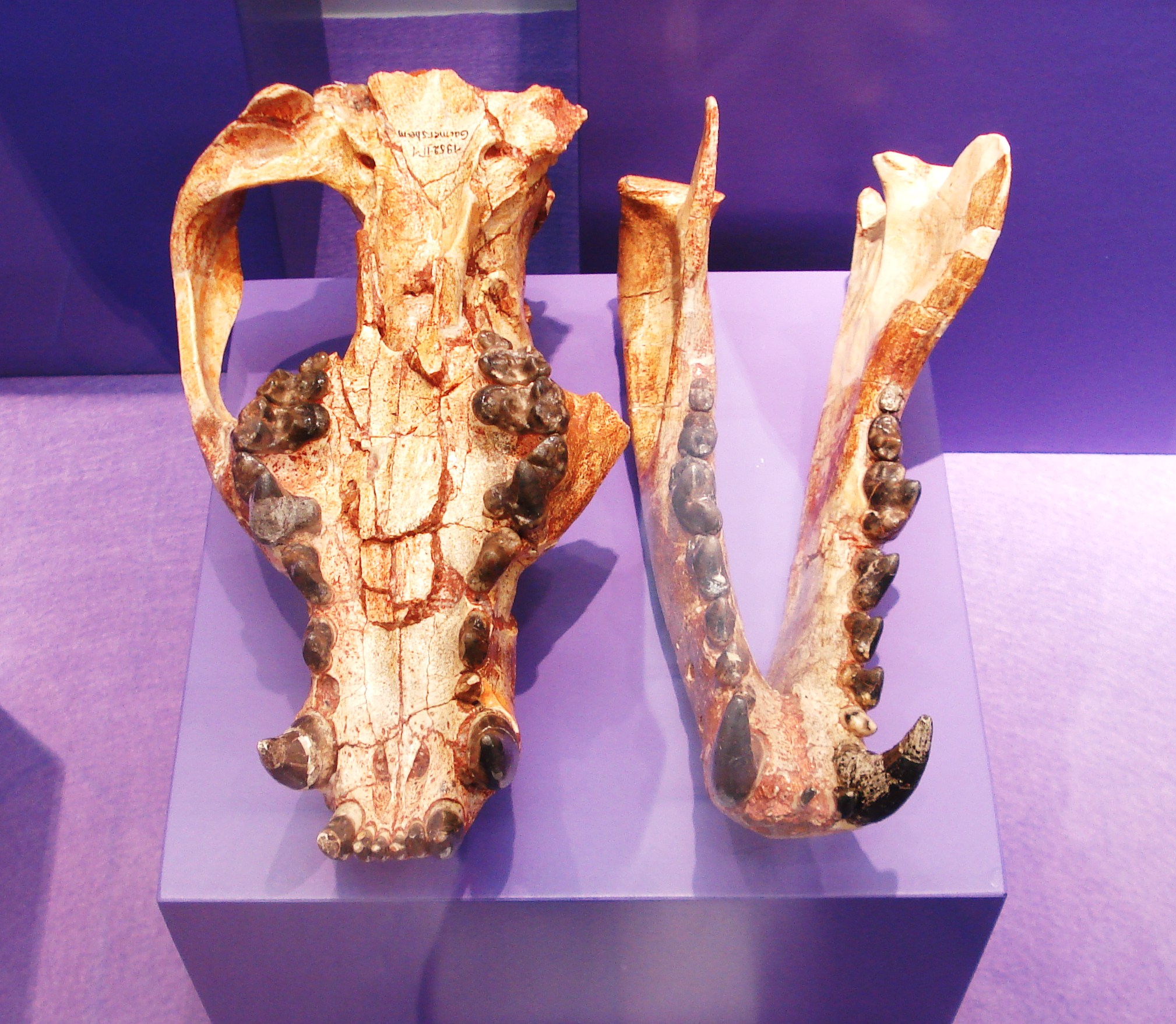암피키온
"오늘의AI위키"의 AI를 통해 더욱 풍부하고 폭넓은 지식 경험을 누리세요.
1. 개요
암피키온은 멸종된 육식 포유류 속으로, 개와 곰을 닮은 특징을 가졌으며, 유럽, 아시아, 아프리카, 북아메리카 등 다양한 지역에서 화석이 발견되었다. 1836년 처음 명명되었으며, 여러 종으로 분류된다. 다리 구조와 치아, 치열을 통해 매복형 포식자였고 중육식 또는 잡식성 식성을 가졌을 것으로 추정된다. 수컷이 암컷보다 컸으며, 일부다처제 사회였을 가능성이 있다. 유럽에서 시작되어 아시아와 북아메리카로 확산되었으며, 멸종 시기는 종에 따라 다르다.
더 읽어볼만한 페이지
- 1836년 기재된 화석 분류군 - 테코돈토사우루스
테코돈토사우루스는 트라이아스기 후기에 유럽에서 서식한 초기 용각류형 공룡으로, 턱뼈에 이빨 소켓이 있는 특징에서 이름이 유래되었으며, 부분적인 화석만 발견되었지만 두 발로 걷고 빠른 속도로 달릴 수 있었을 것으로 추정된다. - 마이오세 유럽의 포유류 - 스콸로돈
스콸로돈은 멸종된 이빨고래의 속으로, 조상 고래와 현대 이빨고래의 특징을 모두 가지며, 원시적인 치열과 반향정위의 기원을 보이는 특징을 나타낸다. - 마이오세 유럽의 포유류 - 데이노테리움
데이노테리움은 멸종된 장비목으로, 아래로 굽은 엄니와 코끼리와 유사한 체형을 가졌으며, 아프리카, 유럽, 아시아 등지에 분포하며 숲에서 나뭇잎을 섭취했을 것으로 추정된다. - 마이오세 아시아의 포유류 - 기간토피테쿠스
기간토피테쿠스는 거대한 어금니 화석을 토대로 명명된 멸종된 유인원 속으로, 큰 덩치와 초식 또는 잡식성 식습관을 가진 것으로 추정되지만, 오랑우탄과 더 가까운 관계이며 기후 변화 등으로 멸종했을 가능성이 있고, 미확인 동물의 정체로도 거론된다. - 마이오세 아시아의 포유류 - 스테고돈
스테고돈은 플라이오세와 플라이스토세에 아시아와 아프리카에 살았던 코끼리와 비슷하지만 더 큰 엄니와 독특한 어금니를 가진 멸종된 장비목 동물이며, 일부 종은 섬왜소화를 겪었고 인류와 공존하기도 했으나 아시아코끼리와의 경쟁, 환경 변화, 인류 활동 등으로 멸종된 것으로 추정된다.
| 암피키온 - [생물]에 관한 문서 | |
|---|---|
| 기본 정보 | |
 | |
| 학명 | Amphicyon |
| 명명자 | Lartet, 1836년 |
| 모식종 | Amphicyon major |
| 모식종 명명자 | Blainville, 1841년 |
| 하위 분류군 | |
| 기타 종 | A. giganteus?|Schinz, 1825년 A. palaeindicus?|Lydekker, 1876년 A. gutmanni|Kittl, 1891년 A. lydekkeri?|Pilgrim, 1910년 A. shahbazi|Pilgrim, 1912년 A. frendens|Matthew, 1924년 A. ingens|Matthew, 1924년 A. reinheimeri?|Cook, 1926년 A. lactorensis|Astre, 1928년 A. eppelsheimensis|Weitzel, 1930년 A. pontoni?|Simpson, 1930년 A. cooperi|Pilgrim, 1932년 A. pithecophilus|Pilgrim, 1932년 A. sindiensis|Pilgrim, 1932년 A. confucianus?|Young, 1937년 A. riggsi?|McGrew, 1939년 A. tairumensis?|Colbert, 1939년 A. longiramus|White, 1942년 A. astrei|Kuss, 1962년 A. olisiponensis?|Antunes & Ginsburg, 1977년 A. pannonicus|Kretzoi, 1985년 A. laugnacensis|Ginsburg, 1989년 A. ulungurensis|Qi, 1989년 A. lathanicus|Ginsburg, 2000년 A. galushai|Hunt, 2003년 A. zhanxiangi|Jiangzuo et al, 2019년 |
| 동의어 | |
| 생물학적 분류 | |
| 색 | 동물 |
| 화석 범위 | |
| 시기 | 전기 마이오세 ~ 후기 마이오세 ~ |
2. 분류
ἀμφί|암피|grc는 '양쪽', κύων|키온|grc은 '개'를 의미하는 고대 그리스어 단어로, 1836년 프랑스 고생물학자 에두아르 라르테가 프랑스 제르 지역의 상상에서 발견한 화석을 바탕으로 명명했다. 라르테는 이 동물이 너구리와 개의 특징을 모두 가졌다고 보았다.[1]
''암피키온'' 속은 크게 유럽, 아시아, 북아메리카에 서식했던 종으로 분류할 수 있다.
2. 1. 유럽의 종
1836년 프랑스 지질학자 알렉상드르 레메리에는 에두아르 라르테에게 제르 지역, 특히 상상의 고생물학적 유적 탐사에 대한 편지를 받았다고 언급했다. 라르테는 이 유적에서 "''마스토돈트''"(후에 ''지고로포돈''과 ''곰포테리움''으로 재분류), "''데이노테리움''", "''코뿔소''"(아세라테리움 코뿔소류인 ''호플로아세라테리움''으로 재분류), "''고대말''"(''안키테리움아과''의 ''안키테리움'') 등을 발견했다. 또한, 현존하는 프랑스 사슴 및 영양 크기의 "사슴" 종 화석과 "강력한" 대형 육식동물 화석을 발견했는데, 이 육식동물을 ''암피키온''(Amphicyon)으로 임시 명명했다. 그는 앞니, 송곳니는 너구리와 유사하지만 육식성 어금니와 첫 번째 두 개의 결절은 개와 일치하며, 위턱에 세 번째 결절이 있다는 것이 특징이라고 설명했다.[1]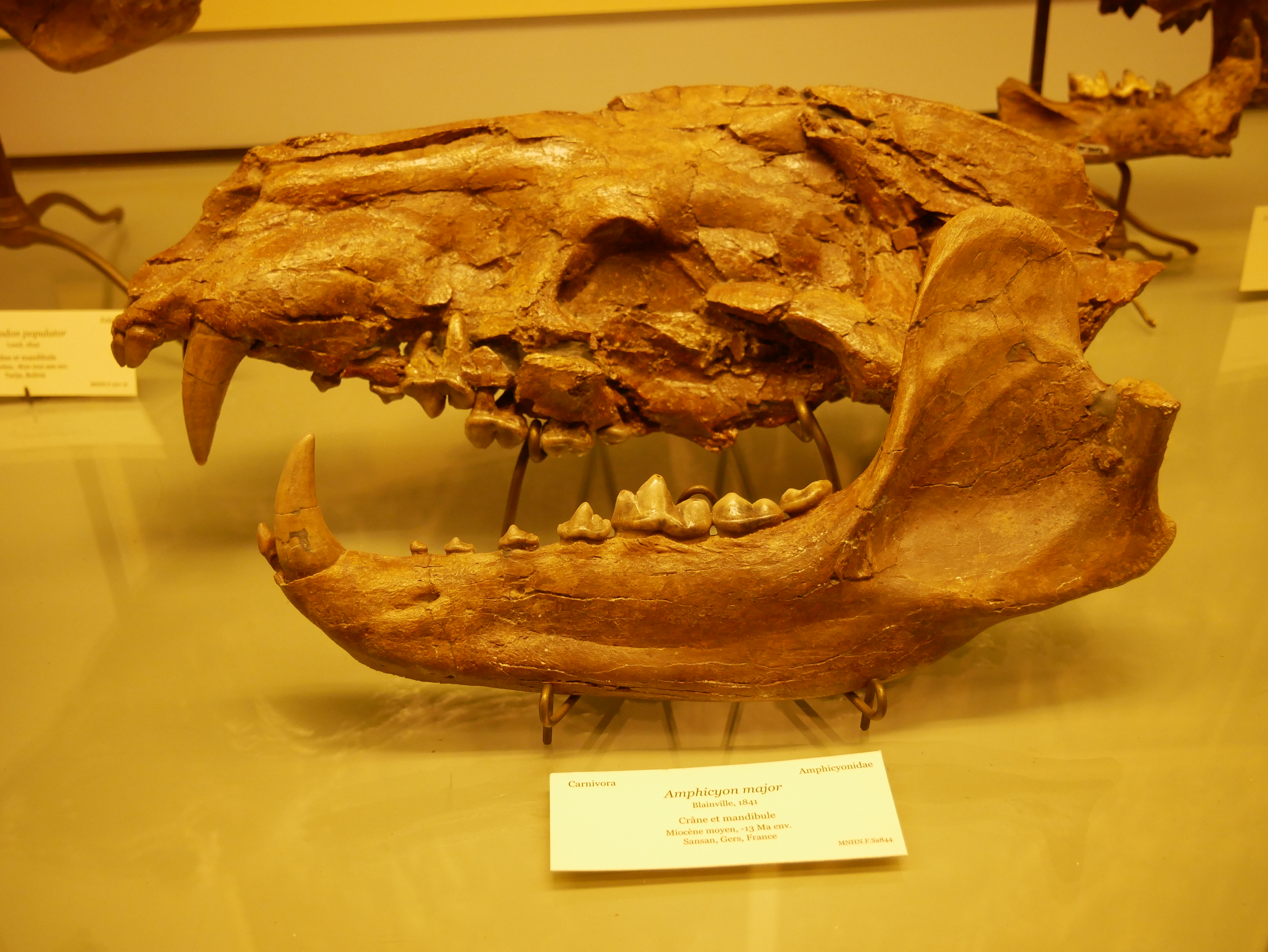
''암피키온''(Amphicyon) 속명이 임시적이었음에도, 앙리 마리 뒤크로테 드 블레인빌은 1841년에 "''암피키온 메이저''(Amphicyon major)''"와 "''암피키온? 마이너''(Amphicyon? minor)''" 두 종을 스케치했다.[1][2] 1851년 라르테는 상상에서 발견된 ''암피키온''(Amphicyon)을 현존하는 곰 크기의 육식 포유류로 재확인했다. 그는 단엽 앞니와 톱니 모양 능선의 송곳니는 너구리와 유사하고, 어금니는 개와 유사하며, 위턱의 세 번째 결절은 ''암피키온 메이저''(Amphicyon major)''에 속한다고 확인했다. 또한 족상 이동의 해부학을 가지며 꼬리가 길고 강했을 것이라고 추측했다. "''암피키온 마이너''(Amphicyon minor)''"는 ''헤미키온''(Hemicyon)으로 재분류되었으며, 유럽늑대보다 크고 개에 가까우며 치열이 족제비와 유사하다고 설명했다. 그는 ''가짜개''(Pseudocyon)'' 속도 설명했는데, 지형성으로 잘못 식별했지만 ''암피키온''(Amphicyon)''보다 작고 개과에 가장 가깝다고 설명했다. 라르테는 세 속 모두 톱니 모양의 송곳니를 가지고 있어, 마이오세 시대 프랑스 최고의 포식자였을 것이라고 말했다.[3]
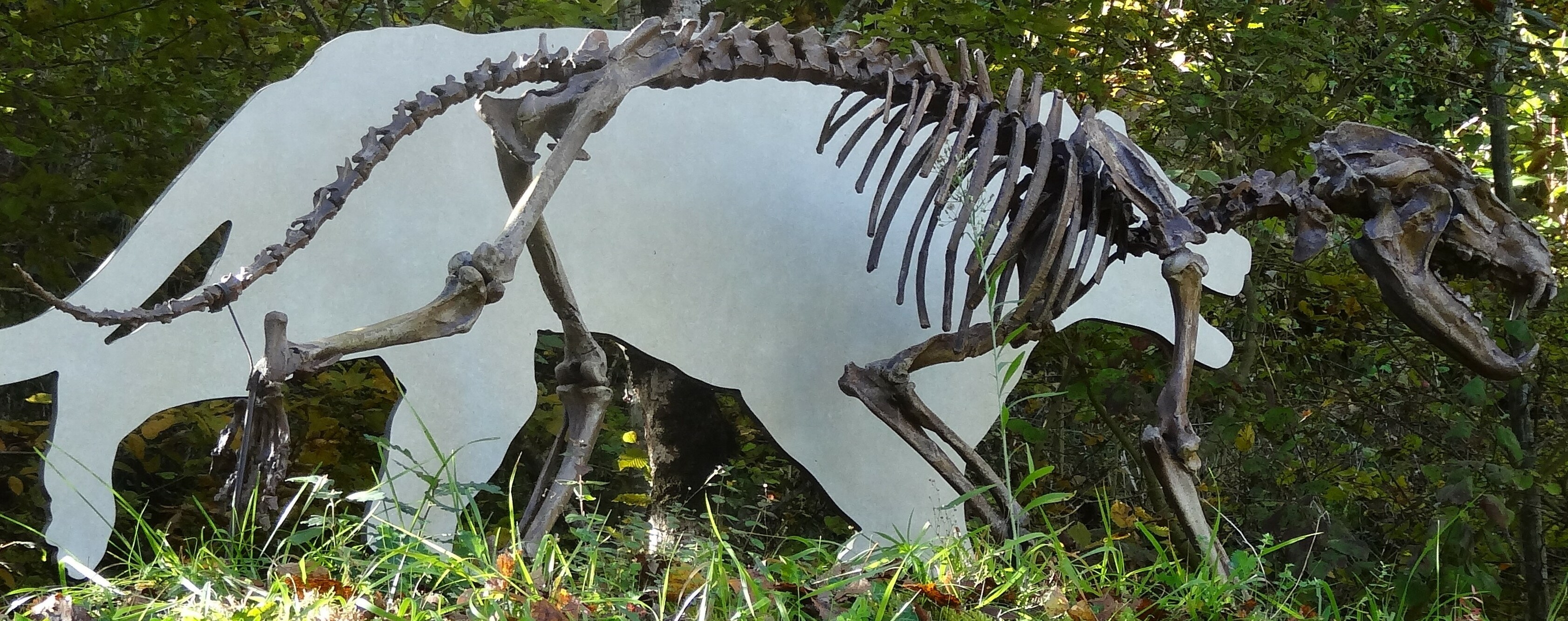
유럽에서 발견된 암피키온 속에는 다음 종들이 포함된다.
2. 2. 아시아의 종
1836년 5월 16일, 프랑스 지질학자 알렉상드르 레메리에는 프랑스 고생물학자 에두아르 라르테에게 보낸 편지에서 프랑스 제르 지역, 특히 상상 코뮌의 고생물학적 유적 탐사에 대해 언급했다. 라르테는 이 유적에서 "''마스토돈트''"(이후 ''지고로포돈''과 ''곰포테리움''으로 재분류), "''데이노테리움''" (''데이노테리움'' 또는 ''프로데이노테리움''으로 재분류), "''코뿔소''" (''호플로아세라테리움''으로 재분류), "''고대말''" (''안키테리움''으로 재분류) 등을 발견했다. 그는 또한 현존하는 프랑스의 사슴 및 영양 크기의 "사슴" 종 화석과 "강력한" 대형 육식동물 화석을 발견했는데, 이 육식동물은 반추동물과 공존했으며, 두 개의 반쪽 턱뼈와 뼈를 바탕으로 ''암피키온''(Amphicyon)으로 임시 명명했다. 라르테는 이 속의 가장 뚜렷한 특징이 위턱의 세 번째 결절이라고 설명했다.[1]''암피키온''(Amphicyon) 속명이 임시적이었음에도, 앙리 마리 뒤크로테 드 블레인빌은 1841년에 "''암피키온 메이저''(Amphicyon major)''"와 "''암피키온? 마이너''(Amphicyon? minor)''" 두 종을 스케치했다.[1][2] 1851년, 라르테는 상상에서 발견된 화석 육식 포유류 속을 검토하면서 ''암피키온''(Amphicyon)을 현존하는 곰 크기의 육식 포유류로 재확인했다. 그는 화석 표본과 위턱의 세 번째 결절이 ''암피키온 메이저''(Amphicyon major)에 속한다는 것을 확인했으며, 족상 이동의 해부학적 특징을 가지고 있다고 설명했다. "''암피키온 마이너''(Amphicyon minor)''"는 ''헤미키온''(Hemicyon)으로 재분류되었으며, 유럽늑대보다 크고 치열이 족제비와 유사하다고 설명했다. 그는 또한 ''가짜개''(Pseudocyon) 속을 설명했는데, ''암피키온''(Amphicyon)보다 작고 개과에 가깝다고 설명했다. 라르테는 세 속 모두 톱니 모양의 가장자리를 가진 송곳니를 가지고 있어, 마이오세 시대의 주요 포식자였음을 시사했다.[3]
아시아에서 발견된 ''암피키온'' 속 종은 다음과 같다.
| 종명 | 명명자 | 발견 지역 | 연대 | 특징 |
|---|---|---|---|---|
| Amphicyon ulungurensis | 중국 울룬구르 강 근처 할라마가이 지층 | 랑기안 초기 | 매우 큰 크기, 위 어금니 특징 부족[33][6], 성적 이형성 가능성[34][35] | |
| Amphicyon zhanxiangi | 중국 닝샤 장언바오 지층, 린샤 분지 후자량 지층 | 샨왕기(Shanwangian) 후기 (MN5), 퉁구르기(Tunggurian) (MN6) | 중간 크기, A. major와 비슷, A. giganteus와 밀접[6], 채식 적응 경향[36] | |
| Amphicyon lydekkeri | 필그림(Pilgrim), 1910 | 파키스탄 Dhok Pathan 지층, 윈난 위안머우, 미얀마 하부 이라와디 지층 | 마이오세 최후기 (7-5 Ma) | Arctamphicyon과 동의어 여부 논란,[34][6] 알려진 암피키온과 동물 중 가장 젊은 종 중 하나[37] |
| Amphicyon cooperi | 필그림(Pilgrim), 1932 | 부기 언덕(Bugi Hills), 데라 부그티(Dera Bugti) | 초기 마이오세 | A. shahbazi와 유사, 외부 치경부 없음[34][38][40] |
| Amphicyon palaeindicus | 리처드 리데커, 1876 | 포트와르 고원 쿠샬가르, 친지, 나그리 구역, 당 계곡 | 중기 마이오세 후기, 발레시안 | Amphicyon 속으로 분류해야 하는지 논란[39][40][41][42][43][44][45] |
| Amphicyon pithecophilus | 필그림(Pilgrim), 1932 | 친지 | M2의 더 큰 메타콘과 더 강한 협측 치경부[40][41][34][6] | |
| Amphicyon sindiensis | 파키스탄 만차르 지층 기저층 | 초기 중기 마이오세 | Maemohcyon과 유사한 크기[34] | |
| Amphicyon shahbazi | 필그림(Pilgrim), 1910 | 부그티 언덕, 상부 치타르와타 지층, 하부 비호와 지층 | 초기 마이오세 | [28][34] |
| Amphicyon confucianus | 샨왕 지역 | 약 16 Ma | 큰 크기, A. ulungurensis와 비슷[34][45], Amphicyon 속으로 분류 불분명[6] | |
| Amphicyon tairumensis | 에드윈 해리스 콜버트, 1939 | 내몽골 퉁구르 지층, 라오고우 | 늑대 크기, A. major보다 작음[46][47][34], Pseudocyon과 더 밀접한 관련 가능성[6][48] |
2. 3. 북아메리카의 종
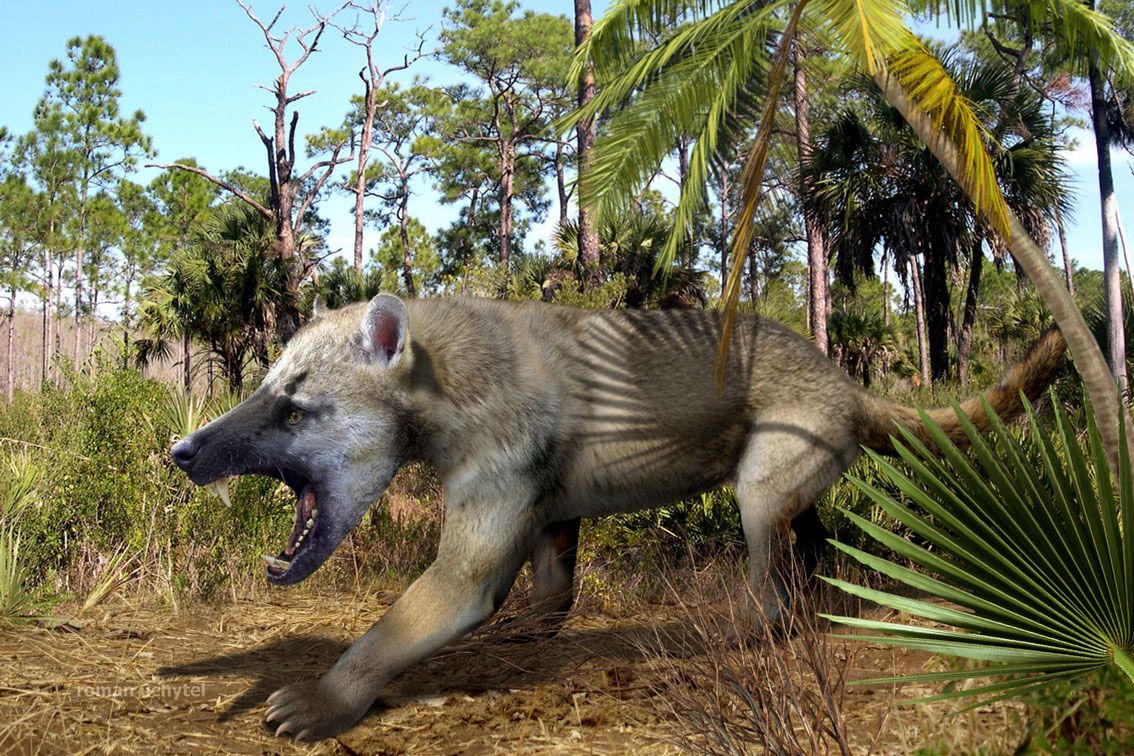
- '''Amphicyon galushai'''
''A. galushai''는 북아메리카에서 최초로 발견된 ''암피키온''(Amphicyon)으로, 약 1880만 년에서 1750만 년 전 헤밍포디안 초기 시대에 살았다. 2003년 로버트 M. 헌트 주니어(Robert M. Hunt Jr.)가 명명했으며, 서부 네브래스카의 러닝워터 형성(Runningwater Formation)에서 발견된 화석으로 가장 잘 알려져 있다. 완전한 성체 두개골, 부분적인 유체 두개골, 3개의 턱뼈와 치아, 그리고 최소 15개체의 척추골이 발견되었다. 콜로라도의 트러블섬 형성(Troublesome Formation)에서도 추가적인 두개골 조각이 발견되었다. ''A. galushai''는 헤밍포디안 후기 종인 ''A. frendens''의 조상으로 여겨진다.
- '''Amphicyon frendens'''
''A. frendens''는 헤밍포디안 후기, 약 1750만 년에서 1590만 년 전에 살았다. 이 종은 1924년 W. 매튜(W. Matthew)가 네브래스카 주, 수 카운티의 쉽 크릭 형성(Sheep Creek Formation) 중부 지층에서 발견된 표본을 토대로 처음 명명했다. 그 이후로 ''A. frendens'' 표본은 오리건 주, 하르니 군과 맬히어 군의 유적지에서도 발견되었다. 이는 초기 종인 ''A. galushai''보다 훨씬 컸으며, 더 큰 M2를 가지고 있었다.
- '''Amphicyon ingens'''
이 거대한 종은 바스토비안 초기에서 중기, 약 1580만 년에서 1400만 년 전에 살았다. 1924년 W. 매튜(W. Matthew)가 네브래스카 주, 수 카운티의 올코트 형성(Olcott Formation)에서 발견된 표본을 토대로 처음 명명했다. 이 종으로 분류된 표본은 그 이후로 캘리포니아, 콜로라도 및 뉴멕시코에서 발견되었다. ''A. ingens''는 어떤 암피키온류보다 가장 큰 송곳니를 가지고 있었다.
- '''Amphicyon longiramus'''
''Amphicyon longiramus''는 1940년 화이트(White)가 플로리다주 호손 형성(Hawthorne Formation)의 토마스 농장에서 발견된 불확실한 종을 지칭하기 위해 "''Amphicyon intermedius''"라는 이름을 사용했으나, 이 명칭은 이미 1849년 폰 마이어(von Meyer)가 독일과 프랑스에서 발견된 타우마스토키온류인 ''Crassidia intermedia''에 사용한 것이었다. 따라서 플로리다의 분류군과는 관련이 없다. 1992년 델라웨어 주 폴락 농장 유적지(Pollack Farm Site)의 칼버트 형성(Calvert Formation) 하부에서도 ''Amphicyon'' 잔해가 발견되었는데, 이는 호손 형성 화석을 ''A. intermedius''로 언급한 것에 근거하여 초기 헤밍포디안 (또는 초기 마이오세)으로 추정된다. 1960년 올슨(Olsen)은 ''A. intermedius''를 ''A. longiramus''의 동의어로 보았고, 2000년 하이츠만과 코르디코바(Heizmann and Kordikova)도 이를 인정하여 ''A. longiramus''가 유효한 이름이 되었다. 플로리다 자연사 박물관의 2012년 ''Amphicyon'' 관련 기사에서도 플로리다와 델라웨어 지역 종들의 유사성을 근거로 ''A. intermedius''를 ''A. longiramus''의 동의어로 언급했다. ''A. longiramus''는 토마스 농장 유적지에서 발견된 더 작은 암피키온류인 ''Cynelos caroniavorus''(White, 1942)와 공존했다.
3. 특징
''암피키온(Amphicyon)''은 매우 큰 포식자로, 다양한 종에 따라 크기가 달랐다. 중간 크기인 ''A. astrei''부터 가장 큰 육식동물 중 하나였던 거대한 ''A. ingens''까지 다양했다. 수컷 ''A. major''는 212kg, 암컷은 122kg으로 성적 이형성을 보였다. 125kg의 어린 암컷은 어깨 높이가 65cm였다.[57] ''A. giganteus''는 암컷 157kg, 수컷 317kg으로 더 컸다.[58][59] 다른 유럽 종들의 질량은 두개치 측정법으로 추정되었는데, 체중을 약간 과대평가했을 수 있다.[60] ''A. astrei''는 112kg, ''A. laugnacensis''와 ''A. lactorensis''는 약 130kg과 132kg, ''A. olisiponensis''는 147kg, ''A. carnutense''는 182kg, ''A. eppelsheimensis''와 ''A. gutmanni''는 각각 225kg과 246kg으로 추정된다.[22] 북미 종은 진화하면서 크기가 증가했는데, ''A. galushai''는 187kg, ''A. frendens''는 432kg, ''A. ingens''는 550kg으로 추정된다.[60][61]
골격은 개과, 곰과, 고양잇과의 특징을 모두 보여준다. ''암피키온''은 길쭉한 주둥이와 높은 시상 능선을 가진 강력한 두개골을 가졌다. 송곳니는 튼튼하고, 뒷 어금니는 확대되었으며, 앞 어금니는 작아졌다. 목은 곰처럼 넓다.[62] 튼튼한 골격, 강력한 사지, 움직이는 어깨 관절, 유연한 손목을 가졌다. 위팔뼈는 아래팔뼈보다 길어 달리기에 적합하지 않았다. 곰과처럼 발바닥으로 걷는 식물성 보행을 했고, 발톱은 집어넣을 수 없었다. 유연한 등과 무거운 꼬리를 가졌으며, 꼬리 척추뼈는 28개로 척추의 나머지 부분만큼 길었을 것으로 추정된다.[45][57]
3. 1. 생태와 행동
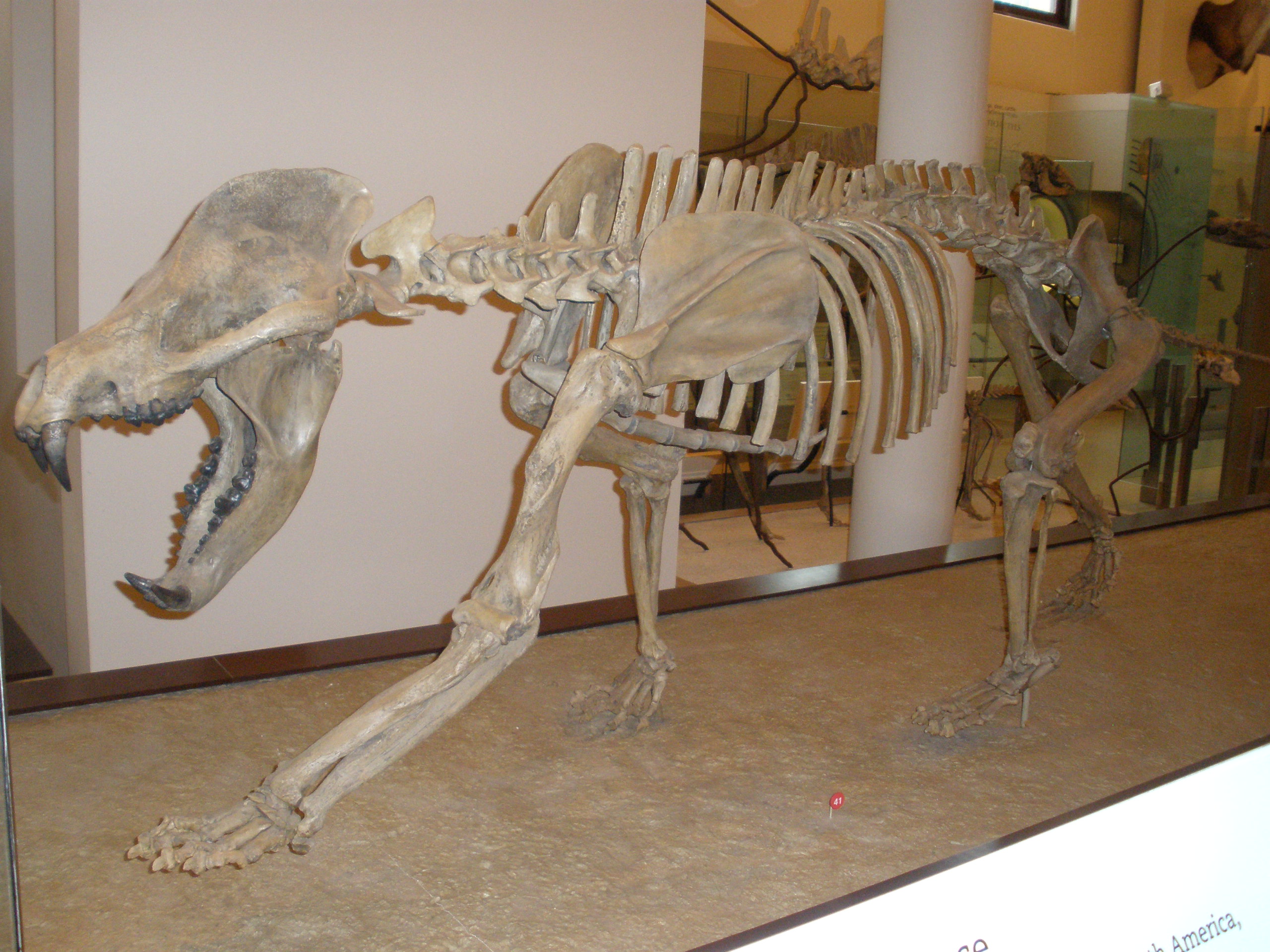
암피키온의 다리 구조는 빠른 추격보다는 기습을 하는 매복형 포식자였음을 보여주며, 고양잇과 동물처럼 앞발로 먹이를 제압했을 것으로 추정된다. 또한, 다른 동물들보다 지구력이 매우 높았던 것으로 보인다.
암피키온의 식단은 치열이 파쇄 및 절단 기능을 모두 가지고 있어 재구성하기 어렵다.[58] 치아 마모 패턴과 형태를 근거로 유럽 종은 뼈를 부수는 중육식동물이었을 것으로 추정된다. 한 연구에서는 ''A. longiramus''가 과육식동물일 가능성이 있다고 주장했는데, 이는 하악 어금니의 상대적인 연마 면적이 육식 개과 동물과 유사하기 때문이다.[63] 반면에 다른 연구에서는 북미 종이 잡식성이었을 것이라고 주장했다.[63][45] ''A. major''에 대한 치아 미세 마모 분석 결과, 이 종의 식단은 붉은 여우와 유사한 중육식성으로 고기는 물론 식물과 뼈를 포함한 단단한 물체를 섭취한 것으로 밝혀졌다.[64] 또 다른 치아 미세 마모 분석 결과는 ''A. giganteus''가 잡식성이었음을 뒷받침하며, 이 종의 치열은 크고 넓은 구멍이 많고 작은 구멍이 여러 개 있으며, 하이에나와 같은 뼈를 부수는 분류군과는 뚜렷이 다르다는 점에 주목했다.[65] 앞 어금니와 뒤 어금니가 모두 감소했기 때문에, ''A. olisiponensis''는 다른 유럽 종보다 더 과육식성이었을 수 있다.[6]
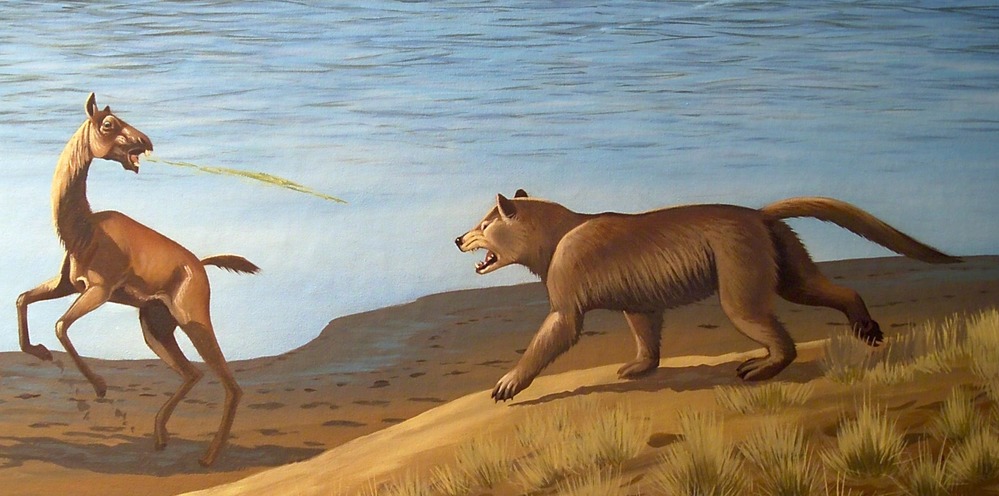
''암피키온''은 빠른 가속을 위한 적응력이 부족하여 사자나 호랑이처럼 먹이에 매우 가까이 접근하여 빠른 속도로 따라잡는 방식과는 달리 사냥했을 것으로 보인다. 하지만 늑대와 같은 현대의 추격 포식자조차 먹이를 몰래 접근하여 매복하기 때문에 ''암피키온''도 그렇게 했을 가능성이 높다. 먹이를 현대 늑대보다 훨씬 느린 속도로 더 먼 거리를 쫓았을 것으로 추정된다. 먹이를 따라잡은 후에는 강력한 앞다리로 움직임을 멈추게 할 수 있었을 것이다. 견갑하와는 어깨 관절을 고정하고 먹이 동물이 벗어나기 위해 발버둥칠 때 상완골 머리가 탈구되는 것을 방지하는 잘 발달된 견갑하근을 나타낸다. 상완골의 해부학적 구조 역시 이를 뒷받침하는데, 강한 회내근이 존재하고, 따라서 팔꿈치의 회내와 회외, 그리고 현존하는 곰과 대형 고양이의 먹이를 잡는 능력에 필수적인 손가락과 손목의 강력한 굴근을 보여준다. 실제로, 상완골의 활차는 호랑이보다 얕아서 앞다리의 회내/회외가 대형 고양이보다 더 컸을 수 있지만, 고양이처럼 발톱을 집어넣는 능력은 부족했을 것이다. 작은 안와하공은 정확한 살상력을 제공하는 고양이의 발달된 수염이 부족했음을 나타낸다. 따라서, 주머니고양이처럼 먹이의 갈비뼈를 찢어 죽이거나 목을 물어 주요 혈관을 끊어 죽였을 수 있다. 현대의 포식자와 마찬가지로, 먹이의 복부를 공격하지 않았을 텐데, 그 부위의 상처는 빨리 죽이지 못하기 때문이다. 원위 사지 분절의 신장이 사회적인 사자보다 고독한 호랑이와 더 유사했기 때문에, ''암피키온''도 고독했을 가능성이 높다. 비교적 느린 최대 속도와 빠른 가속력의 부재로 인해, ''암피키온''이 주행성 유제류를 잡아먹었을 가능성은 낮다. 그러나, 그들의 추격 능력은 merycoidodontids와 코뿔소와 같은 mediportal 유제류를 쫓기에 적합했을 것으로 추정된다.[63] 코뿔소 ''Prosantorhinus douvillei''의 표본이 ''A. giganteus''의 것과 일치하는 물린 자국과 함께 발견되었지만, 이것이 능동적인 포식의 결과인지 단순히 잔해를 청소한 것인지는 불분명하다.[66][67] ''A. olisiponensis'' 종으로 언급된 다른 물린 자국은 대형 탄소류 ''Brachyodus onoideus''의 중족골에서 발견되었다.[68] 체코 초기 마이오세에서 발견된 다양한 포유류의 긴 뼈에 대한 물린 자국 역시 암피키온의 것으로 여겨진다. 패턴화된 뼈는 먹이를 먹는 데 즉각적인 이점이 없으므로, 능동적인 포식의 증거일 가능성이 높다.[69]
3. 2. 성적 이형성
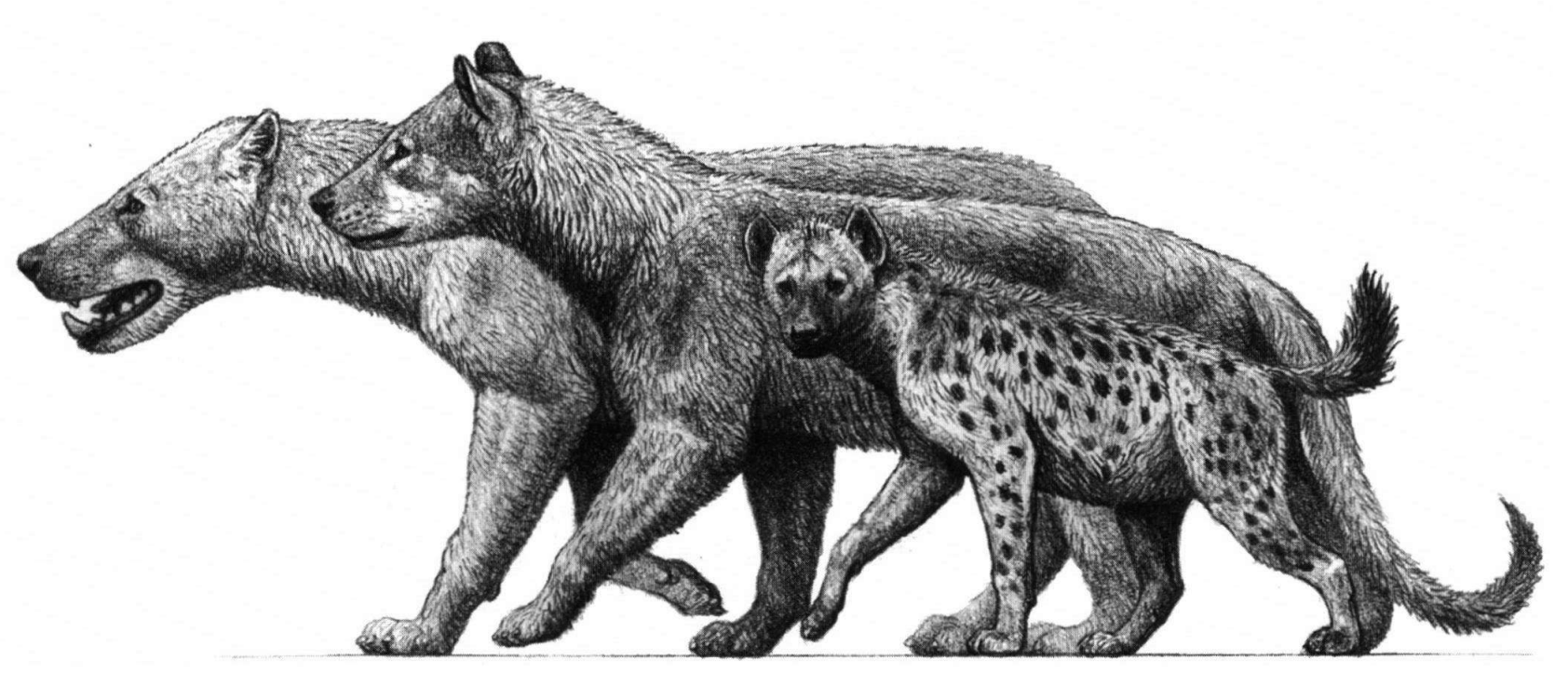
암피키온(Amphicyon)은 유럽과 북아메리카에서 발견된 다양한 종에서 강한 성적 이형성을 보인다. 수컷은 암컷보다 상당히 크다.[70] 이러한 크기 차이는 많은 암피키온과에서 나타나지만, ''키넬로스 레마넨시스(Cynelos lemanensis)''보다 ''암피키온''(Amphicyon)에서 더 강하게 발달했다. 예를 들어, 수컷 ''A. major''의 추정 체중은 212kg인 반면 암컷은 122kg에 불과했다.[57] 이 속의 가장 큰 구세계 종인 ''A. giganteus''는 암컷이 157kg, 수컷이 317kg이었다.[58][59] 또한 수컷은 약간 더 길고 튼튼한 주둥이, 더 큰 송곳니, 그리고 거대한 시상 능선을 가지고 있다. 다른 강한 성적 이형성을 보이는 육식동물과의 비교를 통해, ''암피키온''은 일부다처제였으며, 번식기 동안 영역을 차지한 수컷들이 암컷을 두고 서로 경쟁했을 것으로 추정된다. 이는 속 내에서 관찰되는 크기 증가에 기여했을 수 있다.[45]
4. 화석 분포
- 암피키온*(*Amphicyon*) 속 화석은 유럽, 아시아, 아프리카, 북아메리카 등 다양한 지역에서 발견되었다.
참조
[1]
논문
Nomenclature des mammifères et des coquilles qu'il a trouvés dans un terrain d'eau douce près de Simorre et de Sansan (Gers)
[2]
서적
Osteographie, ou, Description iconographique comparee du squelette et du systeme dentaire des mammiferes recents et fossiles pour servir de base a la zoologie et a la geologie
J.B. Baillière
[3]
서적
Notice sur la colline de Sansan, suivie d'une récapitulation des diverses espèces d'animaux vertébrés fossiles, trouvés soit à Sansan, soit dans d'autres gisements du terrain tertiaire miocène dans le bassin sous-Pyrénéen
J. - A. Portes
[4]
서적
Revision der europäischen Amphicyoninae: (Canidae, Carnivora, Mamm.) ausschließlich der voroberstampischen Formen
https://books.google[...]
Springer-Verlag
1965
[5]
서적
The Miocene Land Mammals of Europe
Pfeil
[6]
논문
Amphicyon zhanxiangi, sp. nov., a new amphicyonid (Mammalia, Carnivora) from northern China
https://doi.org/10.1[...]
2018-11-02
[7]
논문
Temporal and spatial distribution of Miocene mammals in the Western Carpathians (Slovakia)
https://www.research[...]
2002
[8]
논문
New carnivore material from the Middle Miocene of Turkey. Implications on biochronology and palaeoecology
https://www.scienced[...]
2015-01-01
[9]
논문
Evolution of the carnivoran (Carnivora, Mammalia) guild structure across the Middle/Upper Miocene boundary in Germany
https://www.scienced[...]
2020-09-01
[10]
논문
The Vallesian Mammal Turnover: A Late Miocene record of decoupled land-ocean evolution
https://www.scienced[...]
2013-01-01
[11]
서적
Vösendorf: ein Lebensbild aus dem Pannon des Wiener Beckens
http://www.rhinoreso[...]
1954
[12]
논문
Nuevos datos sobre los carnivoros de Los Valles de Fuentiduena (Segovia).
https://www.research[...]
1981
[13]
논문
Neuer Amphicyonide aus dem Altpannon von Pécs (Südungarn)
http://publication.n[...]
1985
[14]
기타
Carnivore Behavior, Ecology, and Evolution
Cornell University Press
2019-05-15
[15]
서적
Programme, Abstracts and Field Trip Guidebook of the 6th Workshop on the Neogene of Central and South-Eastern Europe
https://www.academia[...]
[16]
논문
Les faunes de mammifères terrestres du Miocène moyen des Faluns du bassin de Savigné-sur-Lathan (France)
https://sciencepress[...]
2001
[17]
논문
The Amphicyoninae (Amphicyonidae, Carnivora, Mammalia) Of The Early Miocene From Tuchořice, The Czech Republic
https://zenodo.org/r[...]
2021
[18]
논문
New data on carnivores from the Middle Miocene (Upper Aragonian, MN 6) of Arroyo del Val area (Villafeliche, Zaragoza Province, Spain)
https://estudiosgeol[...]
2006-12-30
[19]
논문
A middle Miocene vertebrate assemblage from the Czech part of the Vienna Basin: Implications for the paleoenvironments of the Central Paratethys
https://www.scienced[...]
2021-08-01
[20]
논문
Systematics and paleobiology of Carnivora and Hyaenodonta from Buluk, Early Miocene, Kenya
2021
[21]
논문
Caught in travertine: computed tomography reveals the youngest record of Amphicyon giganteus from the travertine deposits of Karacalar (late middle Miocene, central Anatolia, Turkey)
https://doi.org/10.1[...]
2022-06-01
[22]
논문
A new gigantic carnivore (Carnivora, Amphicyonidae) from the late middle Miocene of France
2022-06-15
[23]
논문
The Carnivora (Mammalia) from the middle Miocene locality of Gračanica (Bugojno Basin, Gornji Vakuf, Bosnia and Herzegovina)
2020-06-01
[24]
논문
New carnivores from the basal Middle Miocene of Arrisdrift, Namibia
[25]
논문
Creodonta and Carnivora from Arrisdrift, early Middle Miocene of southern Namibia
[26]
논문
New Amphicyonids (Mammalia, Carnivora) from Moghra, Early Miocene, Egypt
https://sciencepress[...]
2019
[27]
논문
The taxonomic status of "Ysengrinia" ginsburgi Morales et al. 1998 (Amphicyonidae, Carnivora) from the basal middle Miocene of Arrisdrift, Namibia.
https://www.mme.gov.[...]
2022
[28]
기타
Chapter 16. Mammalian Neogene Biostratigraphy of the Sulaiman Province, Pakistan
https://www.degruyte[...]
Columbia University Press
2013-05-14
[29]
논문
Les Vertébrés des sables continentaux d'âge orléanien inférieur (MN 3) de Mauvières à Marcilly-sur-Maulne (Indre-et-Loire), La Brosse à Meigné-le-Vicomte (Maine-et-Loire) et Chitenay (Loir-et-Cher)
https://sciencepress[...]
2000
[30]
논문
Les Grands Mammifères du Burdigalien (MN3; Miocène) d'Estrepouy (Gers, France): liste faunique actualisée
https://www.research[...]
2011
[31]
논문
Los carnívoros del Mioceno Inferior de Buñol (Valencia, España)
http://www.sepaleont[...]
1989
[32]
논문
A New Amphicyonine (Carnivora: Amphicyonidae) from the Upper Miocene of Batallones-1, Madrid, Spain
2008
[33]
기타
Chapter 1. Neogene Land Mammal Stages/Ages of China: Toward the Goal to Establish an Asian Land Mammal Stage/Age Scheme
https://www.degruyte[...]
Columbia University Press
2013-05-14
[34]
논문
A new amphicyonid (Mammalia, Carnivora, Amphicyonidae) from the late middle Miocene of northern Thailand and a review of the amphicyonine record in Asia
https://www.scienced[...]
2006-04-01
[35]
논문
Diversity of Amphicyonidae (Carnivora, Mammalia) in the Middle Miocene Halamagai formation in Ulungur River area, Xinjiang, Northwestern China
https://doi.org/10.1[...]
2020-02-07
[36]
논문
New material of Amphicyon zhanxiangi from laogou, linxia basin suggests a possible southern dispersal with increasing omnivory
https://doi.org/10.1[...]
2022-05-04
[37]
논문
Cervid remains from the middle Siwaliks of Hasnot (Late Miocene), Pakistan
https://doi.org/10.1[...]
2014-09-01
[38]
논문
Mise en évidence de l'Oligocène sur le territoire des Bugti (Balouchistan, Pakistan)
https://www.scienced[...]
1997-12-01
[39]
서적
Molar Teeth and Other Remains of Mammalia
https://books.google[...]
Office of Superintendent of Government Printing
1876
[40]
서적
The Fossil Carnivora of India
https://books.google[...]
Government of India, Central Publication Branch
1932
[41]
논문
Siwalik Mammals in the American Museum of Natural History
https://www.jstor.or[...]
1935
[42]
논문
Vertebrate Fauna from Neogene Siwalik Group, Dang Valley, Western Nepal
https://www.jstor.or[...]
1978
[43]
논문
Siwalik-age faunas from the Himalayan Foreland Basin of South Asia
https://www.scienced[...]
2018-08-15
[44]
논문
Preliminary report on the geology and vertebrate fauna of the Miocene Manchar Formation, Sind, Pakistan
https://doi.org/10.1[...]
1984-12-01
[45]
논문
Intercontinental Migration of Large Mammalian Carnivores: Earliest Occurrence of the Old World Beardog Amphicyon (Carnivora, Amphicyonidae) in North America
https://digitalcommo[...]
2003
[46]
웹사이트
Carnivora of the Tung Gur Formation of Mongolia. Bulletin of the AMNH ; v. 76, article 2
https://www.biodiver[...]
2023-03-27
[47]
논문
Carnivora from middle Miocene of northern Junggar Basin, Xinjiang Autonomous Region, China
1998
[48]
논문
Paleobiogeographic implications of additional Felidae (Carnivora, Mammalia) specimens from the Siwaliks
https://doi.org/10.1[...]
2021-09-02
[49]
문서
Third contribution to the Snake Creek Fauna
1924
[50]
서적
Evolution of tertiary mammals of North America, volume 1: Terrestrial carnivores, ungulates and ungulatelike mammals
Cambridge University Press.
[51]
논문
Ecomorphology of the giant bear-dogs ''Amphicyon'' and ''Ischyrocyon''
http://doc.rero.ch/r[...]
[52]
논문
Zur systematischen Stellung von "Amphicyon" intermedius H. v. Meyer, 1849 (Carnivora, Amphicyonidae)
https://www.zobodat.[...]
2000
[53]
논문
A New Thaumastocyoninae (Amphicyonidae, Carnivora) from the Early Miocene of Tuchořice, the Czech Republic
[54]
논문
The Early Hemingfordian (Early Miocene) Pollack Farm Local Fauna: First Tertiary Land Mammals Described From Delaware
[55]
논문
The fossil carnivore Amphicyon longiramus from the Thomas farm Miocene. Part II: postcranial skeleton.
[56]
웹사이트
Amphicyon longiramus
https://www.floridam[...]
Florida Museum of Natural History
2023-04-09
[57]
논문
Morphofunctional analysis of the postcranium of Amphicyon major (Mammalia, Carnivora, Amphicyonidae) from the Miocene of Sansan (Gers, France) compared to three extant carnivores: Ursus arctos, Panthera leo, and Canis lupus
https://sciencepress[...]
2010
[58]
논문
European Miocene Amphicyonidae –taxonomy, systematics and ecology.
1996
[59]
논문
New fossils of Amphicyonidae (Carnivora) from the middle Miocene (MN6) site of Carpetana (Madrid, Spain)
https://digital.csic[...]
2020-06-18
[60]
논문
Body Mass Estimation in Amphicyonid Carnivoran Mammals: A Multiple Regression Approach from the Skull and Skeleton
https://bioone.org/j[...]
2011
[61]
논문
Ecomorphology of the giant bear-dogs Amphicyon and Ischyrocyon
https://doi.org/10.1[...]
2006-12-01
[62]
논문
Comparative Anatomy of the Shoulder Region in the Late Miocene Amphicyonid Magericyon anceps (Carnivora): Functional and Paleoecological Inferences
https://doi.org/10.1[...]
2015-06-01
[63]
논문
Ecomorphology of the giant bear-dogs ''Amphicyon'' and ''Ischyrocyon''
https://www.research[...]
[64]
논문
Relationships between dental microwear and diet in Carnivora (Mammalia) — Implications for the reconstruction of the diet of extinct taxa
https://www.scienced[...]
2009-01-01
[65]
논문
Palaeodietary traits of large mammals from the middle Miocene of Gračanica (Bugojno Basin, Bosnia-Herzegovina)
https://doi.org/10.1[...]
2020-06-01
[66]
논문
Ichnological evidence of a Miocene rhinoceros bitten by a bear-dog (Amphicyon giganteus)
[67]
논문
Revision Of The European Species Of Prosantorhinus Heissig, 1974 (Mammalia, Perissodactyla, Rhinocerotidae)
http://fi.nm.cz/wp-c[...]
2017-12-31
[68]
논문
The last Anthracothere Brachyodus onoideus (Mammalia, Artiodactyla) from westernmost Europe and its extinction
https://run.unl.pt/h[...]
2010-12-30
[69]
논문
Three New Ichnogenera of Biting and Gnawing Traces on Reptilian and Mammalian Bones: A Case Study from the Miocene of the Czech Republic
https://doi.org/10.1[...]
2006-09-01
[70]
서적
The Amphicyonidae (Mammalia: Carnivora) from Ulm-Westtangente (MN 2, Early Miocene), Baden-Württemberg, Germany: systematics and ecomorphology; with 14 tables
https://katalog.ub.t[...]
Staatliches Museum für Naturkunde
2003
[71]
논문
Fossil Creodont and Carnivore Footprints from California, Nevada, and Wyoming
http://www.desertsym[...]
2002
[72]
논문
Large-sized pentadactyl carnivore footprints from the early Miocene fossil track site at Ipolytarnóc (Hungary): 3D data presentation and ichnotaxonomical revision
https://doi.org/10.1[...]
2022-08-16
[73]
논문
Chronological framework and palaeoecology of Carnivora from the Linxia Basin, China
https://www.scienced[...]
2023-04-01
[74]
논문
The last amphicyonid (Mammalia, Carnivora) in Africa
http://www.bioone.or[...]
2009
[75]
논문
The Anatomical Characteristics of a Giant Miocene Amphicyonid (Carnivora) Humerus from Pakistan
https://www.academia[...]
2004
[76]
논문
Biochronological and palaeobiogeographical significance of the earliest Miocene mammal fauna from Northern Vietnam
https://epub.ub.uni-[...]
2018
[77]
논문
The lower Miocene fauna of Al-Sarrar (Eastern Province, Saudi Arabia)
https://cir.nii.ac.j[...]
1982
[78]
논문
A New Amphicyonine (Carnivora: Amphicyonidae) from the Upper Miocene of Batallones-1, Madrid, Spain
2008
[79]
논문
Suidae from the Middle Miocene of Arrisdrift, Namibia
https://www.research[...]
1995
[80]
논문
African Land Mammal Ages
https://doi.org/10.1[...]
2020-12-01
[81]
서적
Lothagam: The Dawn of Humanity in Eastern Africa
https://books.google[...]
Columbia University Press
2003
[82]
논문
Systematics of African Amphicyonidae, with descriptions of new material from Napak (Uganda) and Grillental (Namibia)
https://digital.csic[...]
2016
[83]
논문
Miocene Carnivores, Texas Coastal Plain
https://www.jstor.or[...]
1960
[84]
논문
The Arikareean Land Mammal Age in Texas and Florida: Southern extension of Great Plains faunas and Gulf Coastal Plain endemism
https://www.research[...]
1998-01-01
[85]
논문
Ecomorphology of the giant bear-dogs Amphicyon and Ischyrocyon
https://doi.org/10.1[...]
2006-12-01
본 사이트는 AI가 위키백과와 뉴스 기사,정부 간행물,학술 논문등을 바탕으로 정보를 가공하여 제공하는 백과사전형 서비스입니다.
모든 문서는 AI에 의해 자동 생성되며, CC BY-SA 4.0 라이선스에 따라 이용할 수 있습니다.
하지만, 위키백과나 뉴스 기사 자체에 오류, 부정확한 정보, 또는 가짜 뉴스가 포함될 수 있으며, AI는 이러한 내용을 완벽하게 걸러내지 못할 수 있습니다.
따라서 제공되는 정보에 일부 오류나 편향이 있을 수 있으므로, 중요한 정보는 반드시 다른 출처를 통해 교차 검증하시기 바랍니다.
문의하기 : help@durumis.com

